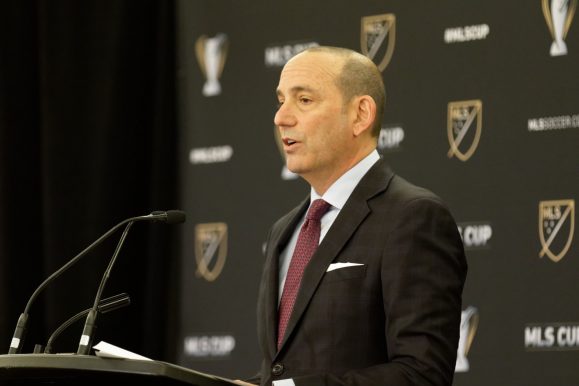If you watched MLS Cup and quickly erased your memory of the last three days to put its ineptitude out of your mind, you will have forgotten the details of MLS Commissioner Don Garber’s annual State of the League address, which was delivered Friday afternoon. This speech, issued before MLS Cup each year, gives the public an update on the strength of the league in terms of business, player matters, community and fan outreach, and other developments. Naturally there is plenty of general self-congratulation and positive spin, and this year was no exception. But several important details were announced or confirmed that will change the game on the pitch in ways large and small.
The full video and transcript of the address can be found on MLS’ website, and other analyses have already gone in depth on some of the more interesting tidbits from the speech. Here, I want to mention some of the bigger developments and consider their impact on Minnesota United specifically.
More Targeted Allocation Money
Garber announced that all clubs in 2017 would receive $1.2 million in Targeted Allocation Money (TAM), $400,000 more than was previously appropriated. Including a full description of how TAM works would exceed the capacity of our webservers and of a normal human ability for understanding. In brief, TAM is money allocated to each team to “buy down” the budget charge of players whose salaries would otherwise exceed the maximum allowable budget for any single player that is not a Designated Player (DP) (in 2017 that salary figure will be $480,625 per year). So a player earning $500,000 annually could have his salary impact reduced to $250,000 by applying $250,000 in TAM. Essentially, this allows teams to bolster those roster spots below their top three by attracting better talent through greater salary flexibility, or to retain talent that might otherwise leave without a boost in salary past the maximum allowed.
Unveiled in 2015, all teams were given $100,000 of TAM annually from 2015 to 2019, then Christmas came early last year and MLS announced an additional $800,000 would be apportioned in 2016 and 2017. Now the 2017 figure is $1.2 million.
Additionally, both Atlanta United FC and Minnesota United FC will receive an additional $300,000 of TAM to bring the new clubs in line with that original $500,000 offered to other clubs.
What does this mean to Minnesota? If United choose to sign any players for 2017, they appear to prefer doing so through a holistic roster build with a view of the long term rather than on pricey DPs (Portland has been cited as a model to follow). TAM will be critical for attracting the caliber of talent United may look to capitalize on: consistent performers worth right around DP money but not $7 million blockbusters. TAM should allow United to enhance the players it can sign at that level while leaving more cap room available at the lower ends of its squad.
Video Assistant Referee
Throughout 2017, MLS will introduce the Video Assistant Referee (VAR), beginning with testing in the first half of the season and aiming to fully implement the concept after the 2017 MLS All Star Game. Unfortunately, the initiative is not a robot with a series of cameras and lasers built in, but rather will be an additional referee positioned in a booth who will have access to every camera angle and will be able to communicate game changing decisions to the officials on the field, including goals allowed or disallowed and straight red card incidents. Importantly, this is not quite the same as “instant replay” or “challenges,” which should very slightly reduce the number of social media screeds on the topic.
This will not have a unique impact on Minnesota, as this rain will fall on the just and unjust alike. However, it will fall to Minnesota’s supporters to lead the way in creating new taunts for the VAR when a call does not go their way, remembering that the VAR will be able to review and re-listen to every pointed barb repeatedly until it haunts his or her dreams. Aside from this, it will be intriguing to consider a competition in which the rules change midway, albeit in a minor way.
Odds and Ends
- Garber indicated that the league now boasts over 150 Homegrown Players. Building a strong academy is not an option these days, and Minnesota would do well to prioritize this aspect of its scaling empire.
- Several initiatives relevant to growing the sport in Canada were mentioned, including a Canada-specific Generation Adidas program and a new rule that allows any US or Canadian academy player to be considered “domestic” on signing their first MLS team or USL affiliate contract. This does not appear specific to Homegrown Players, and it does not seem that a player must sign with the club whose academy he belonged to. Time for United to begin plundering that Canadian academy talent.
- Garber confirmed a current target of 28 teams in the league and indicated that more details on the next four expansion opportunities could be released as early as December 15th.
- Atlanta and Minnesota both made mention in the address. Atlanta was cited as having sold over 22,000 season tickets, while Minnesota was quoted as nearing its cap for season tickets. The specificity of the Atlanta number immediately juxtaposed with the vagueness of the Minnesota number was telling for those of us with our #PANIC tweets at the ready. However, the Itasca Society of original Minnesota MLS season ticket holders is a number in the 11,000 range, and it may be that putting one United’s number in the same sentence as the other United’s number would seem disparaging of the quieter United of the north.
- The commissioner pronounced Adidas “AH-dee-DAS” rather than “ah-DEE-das.” Fascinating stuff.

Leave a Reply